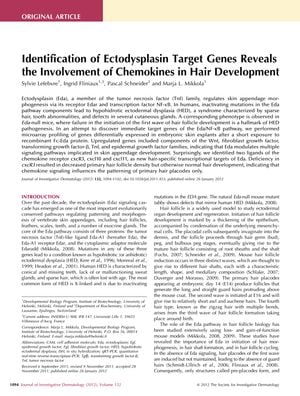Identification of Ectodysplasin Target Genes Reveals the Involvement of Chemokines in Hair Development
January 2012
in “
The journal of investigative dermatology/Journal of investigative dermatology
”

TLDR Chemokine signaling is important for hair development.
The study identified that Ectodysplasin (Eda) regulated skin appendage morphogenesis through its receptor Edar and transcription factor NF-κB, with mutations in this pathway causing hypohidrotic ectodermal dysplasia (HED) characterized by sparse hair and other abnormalities. Using microarray profiling on embryonic skin explants exposed to recombinant Fc-Eda protein, researchers found that Eda influenced multiple signaling pathways, including Wnt, fibroblast growth factor, and Tnf. Notably, they discovered that chemokine ligands cxcl10 and cxcl11 were new hair-specific transcriptional targets of Eda. A deficiency in the chemokine receptor cxcR3 led to decreased primary hair follicle density, suggesting that chemokine signaling played a role in the patterning of primary hair placodes.



